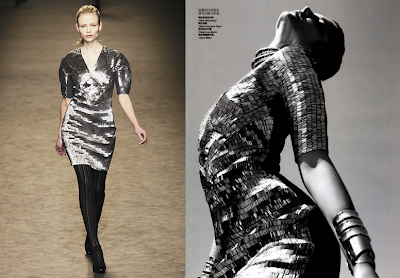Zoot Suits - 1920s -1930s
The Zoot Suit street trend emerged in the U.S., within Latino and Afro-American neighborhoods. Fabric was generously used in the creation of the lengthy blazer and the baggy and high-waisted pants. The Zoot Suit became mainstream but the trend ended with the introduction of the Bold Look in the late 1940s and textile restrictions of WWII.
American Zoot Suit from LIFE magazine 1942:

Lengthy and baggy suits; Dior Spring 2010 Menswear:


Beatniks - 1940s
The beatnik street trend originated with existentialist intellectuals and artists during the 1940s in San Francisco, CA. Their anti-materialism inspired the hippies’ movement of the 1960s. The term “beat” was created by Jack Kerouac at the beginning of the 1950s. Beatniks listened to jazz music and wore dark sunglasses which they called "shades" to imitate the look of jazz musicians. Black clothing and black berets became a staple with beatnik dancers, intellectuals, and artists.
Scenes from the The Beat Generation movie 1959:


Beatniks on the bank of the Seine in Paris, France from Life magazine 1963:

Black sunglasses, beret, shoes, and clothing; Marc by Marc Jacobs Fall 2008 RTW:


Teddy Boys - 1950s
The Teddy Boy street trend began in England during the 1950s and then the trend spread to the U.S. Middle and lower class youth looking to reject the conventional fashion of the 1950s turned to Edwardian elegance. Teddy Boys wore Edwardian-era clothing such as draped jackets with velvet collars, narrow ties and peg trousers.
British Teddy Boys 1953 from the Museum of London:

Edwardian elegance, narrow tie, and velvet collar; Lanvin Spring 2010 Menswear and Viktor & Rolf Fall 2009 Menswear:


Mods - 1960s
The mod (short for modern) street trend started in England in the 1960s. Some famous mods are David Bowie, The Who, and The Beatles. Mods sported tailored clothing that was brightly colored and often Italian designed. Mod prints were paisley, large floral, or geometric prints. Mods drove scooters (i.e. Vespa, Lambretta, Piaggio).
British band The Beatles 1963:

British Mods 1963 from the Museum of London:

Italian tailored suit with geometric print shirts; Gucci Spring 2010 Menswear:


Hippies - 1960s
The anti-war movement sparked the hippie street trend of San Francisco, CA in the 1960s. The terms flower power and flower child originated from protesters handing out flowers at anti-war demonstrations. Hippie fashion consisted of flowing ethnic (i.e. Native American, Indian, Asian, etc.) clothes, long hair, and jeans. Hippie clothing was romantic, psychedelic, and more ornate than the Mod style. It was the opposite of “plastic,” a term coined by hippies meaning fake or not natural.
Hippie group in San Francisco, CA 1967 by Irving Penn:

Hippie couple at the Woodstock Music & Art Fair 1969 from LIFE magazine:

Romantic, ornate prints, leather-fringed handbags; Anna Sui Fall 2009 RTW:


Disco - Early 1970s
Disco started in the U.S. during the 1970s. Disco fashion consisted of futuristic, synthetic, and colorful materials; these clothes were outrageous and shown off at disco dance clubs. Materials worn by the disco dancers included spandex, lurex, lycra, rayon, gold lame, dazzling rhinestones, sequins, and body glitter.
Swedish disco band ABBA in concert in the 1970s:


Bright cobalt blue and diamond white sequins; Balmain Fall 2009 RTW:


Punk - Late 1970s
The Punk style trend began in the late 1970s in Europe and the urban U.S. cities. Combat boots, tight jeans, oversized t-shirts were basics in the punk wardrobe. Punk gear also included clothing that was ripped, made with trashy fabrics (plastic, PVC vinyl, mock leopard prints), and unusual colors that were not mainstream. The Punk Mohawk hairstyle originated from the Mohawk Indians.
British punk rock band the Sex Pistols in the 1970s:
Bright-colored Mohawk hair, mock leopard print, and oversized shirt; Blaak Homme Spring 2010 Menswear:
The hip hop street trend appeared in low-income urban areas of the U.S. in the 1980s. This street trend was largely influenced by the fashions worn by rap artists Run DMC and LL Cool J. These rap artists favored track suits, Adidas sneakers, Kangol hats, and finished their look with a showpiece chain necklace. Matching sportswear became popular with fans which copied their favorite rappers' looks.
Run DMC in Paris, France 1987 by Ricky Powell:

LL Cool J in the 1980s:


Track suit, sneakers, hats, and chain necklace; DSquared2 Spring 2009 Menswear and Y-3 Spring 2009 RTW:


Diva Glitterati - 2000s
Pop divas such as Katy Perry and Lady Gaga have emerged recently with hit dance songs titled "I Kissed A Girl" and "Just Dance". These songs alone describe their incredible energy and sexiness. Their fashion taste is strong in vibrant colors, animal prints, and sparkling sequins.
Katy Perry wearing a sequin dress from Patricia Field Boutique and a-morir by Kerin Rose Schubert sunglasses:


Lady Gaga publicity photo 2008:

Vibrant colors, animal prints, and sequins; Diva Glitterati high fashions in Gucci Fall 2009 RTW and Stella McCartney Fall 2009 RTW:


Urban Gentleman - 2000s
Kanye West hit stardom with his innovative take on rap music. He has become a fashion icon and attends fashions shows along with currently interning at The Gap. He has also designed a line of sneakers for Louis Vuitton that was produced by La MJC in Paris. He favors vintage-looking clothing (tailored blazers and pants, etc.) but adds his own flair with sneakers, a scarf/bowtie/tie, and pops of color.
Kanye West at Lanvin Spring 2008 RTW, Lanvin Fall 2008 RTW with Mario Testino, Yves Saint Laurent Fall 2008 RTW, and Louis Vuitton sneakers designed by Kanye West:




Vintage-looking tailored clothing, bow ties, sneakers, and pops of color; Urban Gentleman high fashions in Viktor & Rolf Fall 2009 and 2010 Menswear:


Alinda Norasing



